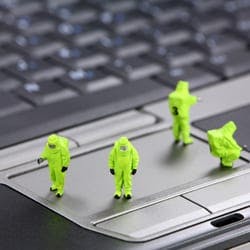If you’re planning to deploy new IT gear this summer, have you thought about how to recycle your current electronic devices including protecting critical business and personal data when you opt to do so?
Many organisations have clear document retention policies that specify how long important data, such as financial or customer records, need to be kept. But many of these same organisations do not have clear policies for handling data that no longer needs to be retained or for disposing of old computers, hard drives, servers and other data storage devices. Do you really want to run the risk of your data being extracted from a computer tip on the west coast of Africa as highlighted in a recent SBS Dateline documentary.
It’s important to understand that valuable information – financial information, irreplaceable and sentimental photos, videos, tax forms, contact lists and passwords – are often still on the computer or mobile device at the time of disposal.
Simply “deleting” all of the files stored on a hard drive or other storage device before recycling it does not protect those files from being recovered. Even a novice computer user could run a data recovery software program on the drive and recover many or all of the deleted files.
Physically destroying the drive using a power drill, hammer or other tools certainly reduces the possibility of data recovery, but Ontrack Data Recovery engineers could give you many examples of how they have recovered data from drives that were crushed, impaled, cracked and seemingly dead.
The spectrum of products that claim to “erase” data from a hard drive is wide and varied. Erasure utilities can be found easily and cheaply (even free), but you get what you pay for as most of these applications simply erase your file “index” or do not go far enough in completely overwriting the data.
Your safest bet for ensuring that sensitive data is no longer accessible is to use a well-proven data erasure software product or a hardware device called a “degausser”. A degausser uses strong magnetic fields to demagnetise a drive – destroying the data in the process.
At a minimum, here are some tips to help you through the data erasure process:
- Clear your computer of personal information and critical business data. Delete does not mean delete. Deleting everything from your computer’s drives and folders and emptying the trash can on your computer does not guarantee your data is gone. Personal information or critical business data including the Internet browser’s cache, cookies, history; email contacts and messages; documents; recycle or trash folders; and all nontransferable software may still reside on your machine’s hard drive. The first step in a safe disposal is to run a disk-cleaning utility that overwrites all the sectors of your hard drives, making your personal and business data unrecoverable.
- Determine if your old computer can be reused. Computers less then five years old can be put to good use by someone else. Non-profit groups, child day care centres and many other organisations often depend on technology that is donated because it is too expensive to keep up with the latest products on their own. Options to donate/recycle include sending your device back to the original manufacturer, dropping off your device at a local recycler or refurbisher, or providing it directly to an organisation in need. The advantage to going through the manufacturer, a refurbisher or a recycler is that they will “wipe” the hard drive of your data and ensure that the equipment they send to nonprofits is in good working condition and runs legal copies of software.
Whether you donate your computer directly to an organisation or via a recycler, refurbisher or manufacturer, be sure you clarify which party is going to wipe your hard drive of your personal information.
- Contact your local recycler or hardware manufacturer prior to donating. Call the organisation or check its web site to ensure that it accepts the type of computer you plan to give away.
- Recycle old and broken hardware. Any equipment that is not working or is more than five years old should be tagged for recycling. A computer recycler will salvage useful computer parts and safely removing hazardous materials in the process before breaking down what’s left.
- Remember the accessories. If you can, be sure to include the keyboard, mouse, printer, or any other accessories you use with the computer when you donate it. Schools and nonprofits can almost always put them to good use, and most organisations only accept complete systems.
Today, there’s a genuine and justified fear within organisations that as mobile device capabilities and storage capacities increase so do the potential data loss disaster scenarios. There are literally thousands of mobile devices lost or stolen worldwide every day and many of these devices contain vast amounts of business sensitive and critical data.
So, don’t let the good deed of donating your IT equipment for recycling turn into a nightmare because the wrong person inadvertently got access to your most important data.

